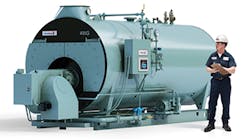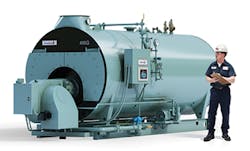Regarded as the “birthplace of teacher education in America,” Bridgewater State University in Bridgewater, Mass., started with 28 students in 1840. Today, the public liberal-arts school educates more than 11,000 students on a 278-acre campus.
Over the past decade, Bridgewater State has made a number of sustainability improvements. Among them is the conversion of its central steam plant from No. 6 oil to natural gas.
Built in 1964, the steam plant was running three watertube boilers powered with No. 6 oil, which provided high-pressure steam to 10 buildings on campus.
“The main reason for converting to natural gas was the cost of No. 6 oil at the time, with the environmental emissions of burning oil a very close second,” Greg Folsom, assistant chief engineer for Bridgewater State, said.
Additionally, the university’s boilers were nearing 50 years of age, parts were becoming scarce, and the costs of properly maintaining the boilers were escalating. The university realized the need to replace the deaerator tank and some fuel-handling equipment for operation of the plant to continue.
In 2011, the university conducted a cost analysis for conversion of the steam plant from No. 6 oil to natural gas. The study showed a conversion would pay for itself in five to seven years.
Bridgewater State consulted with an engineering firm. The firm specified two new 800-hp gas-fired, high-pressure steam boilers and accessories with best available control technology, which would enable the university to take advantage of available rebates.
Shawn O’Connor, senior sales engineer for Randolph, Mass.-based Frank I. Rounds Co., recommended Cleaver-Brooks 4WG wetback firetube boilers with low-NOx burners, stack economizers, and Hawk 4000 programmable-logic-controller-based control system with oxygen trim, variable-speed drive, and parallel positioning.
Bridgewater State installed the two boiler systems along with a new deaerator system, new feedwater pumps, steam flow meters, exhaust fans, and a UL-approved, prefabricated boiler flue-gas stack in April 2013.
“A unique point about this installation is that the economizers were taken into the boiler room early and supported off of the boiler-room ceiling,” O’Connor said. “The two economizers were attached to a steel structure in mid-air. They looked like big chandeliers hanging from the ceiling.
“Two weeks later, they slid the boilers underneath the structures and lowered the economizers onto the stacks,” O’Connor continued. “They positioned the flue outlets underneath the economizers, dropped the plumb bob to make sure they were level, and then cranked the economizer chain claws onto each boiler’s outlet.”
Bridgewater State decommissioned one of its three watertube boilers prior to installing the new firetube boilers, which made the unique installation possible. About a year after the new boilers were in place, the university decommissioned its remaining two watertube boilers.
In addition to being user-friendly, easy to maintain, and reliable, the boilers achieve sub-30-ppm NOx levels, meeting the permanent-emissions requirement for Massachusetts.
According to the university, the fuel-to-steam efficiency of the boilers with economizers is about 84 percent. When the previous boilers were tuned perfectly, their efficiency was only in the mid-70s.
The first year of operation, despite an extremely cold winter, the university’s fuel cost was $800,000 less than the prior year. The following year, the university’s cost savings was $850,000.
Bridgewater State presumes it saved enough to pay for the project in only 27 months.
An additional perk of converting the central boiler plant to 100 percent natural gas was the ability to decommission and demolish a 150-ft-tall radial stack, which university officials said was the last visible trace of dirty energy production at the school.










